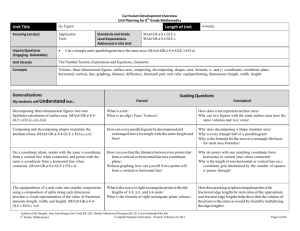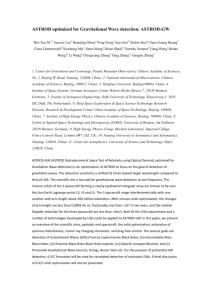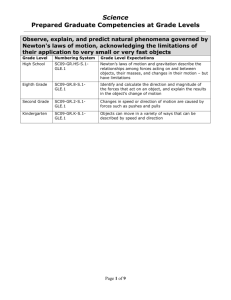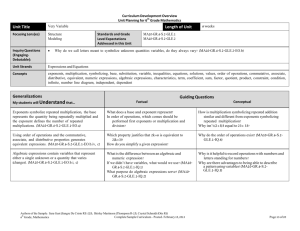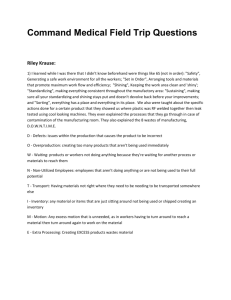Word
advertisement
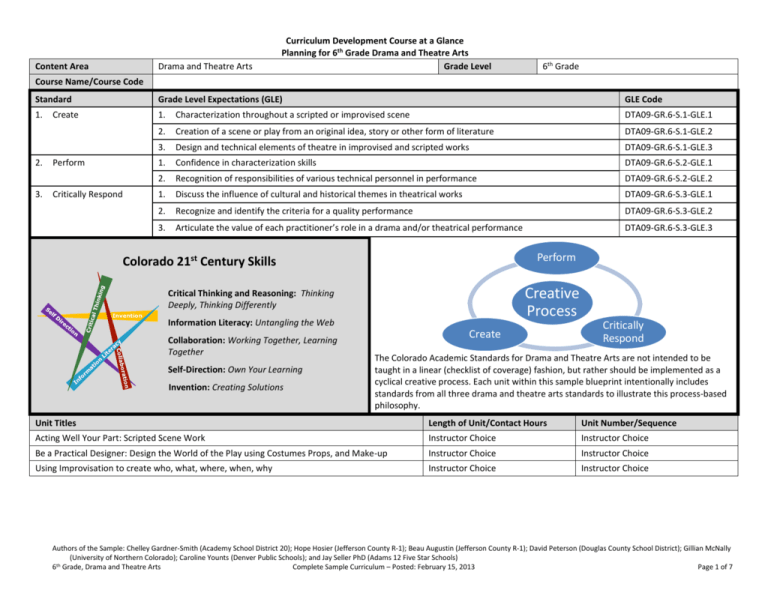
Content Area Drama and Theatre Arts Curriculum Development Course at a Glance Planning for 6th Grade Drama and Theatre Arts Grade Level 6th Grade Course Name/Course Code Standard Grade Level Expectations (GLE) GLE Code 1. 1. Characterization throughout a scripted or improvised scene DTA09-GR.6-S.1-GLE.1 2. Creation of a scene or play from an original idea, story or other form of literature DTA09-GR.6-S.1-GLE.2 3. Design and technical elements of theatre in improvised and scripted works DTA09-GR.6-S.1-GLE.3 1. Confidence in characterization skills DTA09-GR.6-S.2-GLE.1 2. Recognition of responsibilities of various technical personnel in performance DTA09-GR.6-S.2-GLE.2 1. Discuss the influence of cultural and historical themes in theatrical works DTA09-GR.6-S.3-GLE.1 2. Recognize and identify the criteria for a quality performance DTA09-GR.6-S.3-GLE.2 3. Articulate the value of each practitioner’s role in a drama and/or theatrical performance DTA09-GR.6-S.3-GLE.3 2. 3. Create Perform Critically Respond Perform Colorado 21st Century Skills Creative Process Critical Thinking and Reasoning: Thinking Deeply, Thinking Differently Invention Information Literacy: Untangling the Web Collaboration: Working Together, Learning Together Self-Direction: Own Your Learning Invention: Creating Solutions Create Critically Respond The Colorado Academic Standards for Drama and Theatre Arts are not intended to be taught in a linear (checklist of coverage) fashion, but rather should be implemented as a cyclical creative process. Each unit within this sample blueprint intentionally includes standards from all three drama and theatre arts standards to illustrate this process-based philosophy. Unit Titles Length of Unit/Contact Hours Unit Number/Sequence Acting Well Your Part: Scripted Scene Work Instructor Choice Instructor Choice Be a Practical Designer: Design the World of the Play using Costumes Props, and Make-up Instructor Choice Instructor Choice Using Improvisation to create who, what, where, when, why Instructor Choice Instructor Choice Authors of the Sample: Chelley Gardner-Smith (Academy School District 20); Hope Hosier (Jefferson County R-1); Beau Augustin (Jefferson County R-1); David Peterson (Douglas County School District); Gillian McNally (University of Northern Colorado); Caroline Younts (Denver Public Schools); and Jay Seller PhD (Adams 12 Five Star Schools) 6th Grade, Drama and Theatre Arts Complete Sample Curriculum – Posted: February 15, 2013 Page 1 of 7 Curriculum Development Overview Unit Planning for 6th Grade Drama and Theatre Arts Unit Title Acting Well Your Part: Scripted Scene Work Focusing Lens(es) Relationships Inquiry Questions (EngagingDebatable): Unit Strands Create, Perform, Critically Respond Concepts Culture, Value, Expression, Influence, Observation, Conflict, Scripted Material, Perspective, Character, Scene, Hierarchical Character Relationships, Complexity, Emergence, Revelation Standards and Grade Level Expectations Addressed in this Unit Length of Unit Quarter/Instructor Choice DTA09-GR.6-S.1-GLE.1, DTA09-GR.6-S.1-GLE.2, DTA09-GR.6-S.1-GLE.3 DTA09-GR.6-S.2-GLE.1, DTA09-GR.6-S.2-GLE.2 DTA09-GR.6-S.3-GLE.1, DTA09-GR.6-S.3-GLE.2, DTA09-GR.6-S.3-GLE.3 How does creating characters through rehearsal and performance enhance real-world relationships? (DTA09-GR.6-S.1-GLE.1) and (DTA09-GR.6-S2GLE1) and (DTA09-GR.6-S.3-GLE.1,2,3) How does creating characters enhance understandings about tension and conflict in societal relationships? How does the ensemble connect with the development of the performance of each character? How do the given elements, such as: set, character, and plot of the play affect the performance of scripted material? Generalizations My students will Understand that… Guiding Questions Factual Conceptual Cultural conflicts and cultural expressions are often revealed through the observed relationships that emerge in scripted material (DTA09-GR.6-S.1-GLE.1,EO.a) and (DTA09-GR.6-S.3-GLE.1,2,3) What kind of relationship exists within a given script? What type of cultural relationships can be observable and gleaned from scripted material? Why do cultural conflicts exist within relationships? How do relationships in a script control character choices? How can cultural differences enhance or distract from relationship building? Character’s perspectives and expressions reveal cultural values to other characters within a scene (DTA09-GR.6-S2GLE1) What possible character decisions can be defined in a given script? What types of cultural perspectives exist among characters within a scene or script? How might an actor’s choices be limited by other actors? How might a character’s cultural perspectives create value in a plot? Influential (such as hierarchical) character relationships create complexity for character development (DTA09-GR.6-S.1-GLE.1) and (DTA09-GR.6-S.3-GLE.1,2,3) What types of character expressions inform the audiences’ reaction to the play? What determines status and influence for a character in a play? How might an actor construct a believable and unique character? How can status and influence affect relationships? Cultural backgrounds and experiences promote and encourage performers’ exploration of character choices in scripted material (DTA09-GR.6-S2-GLE1) and (DTA09GR.6-S.3-GLE.3) What can actors glean from their own culture and personal experiences to create a character? What types of cultural backgrounds could be explored through character development? How do differing cultural backgrounds impact the production? How do actors draw on their own culture and experience to create a character? Authors of the Sample: Chelley Gardner-Smith (Academy School District 20); Hope Hosier (Jefferson County R-1); Beau Augustin (Jefferson County R-1); David Peterson (Douglas County School District); Gillian McNally (University of Northern Colorado); Caroline Younts (Denver Public Schools); and Jay Seller PhD (Adams 12 Five Star Schools) 6th Grade, Drama and Theatre Arts Complete Sample Curriculum – Posted: February 15, 2013 Page 2 of 7 Curriculum Development Overview Unit Planning for 6th Grade Drama and Theatre Arts Critical Content: Key Skills: My students will Know… My students will be able to (Do)… How scripts differ in terms of reading, design and notation (DTA09-GR.6-S.1-GLE.1) Parts of a play script, such as exposition, conflict, climax, and resolution (DTA09GR.6-S2-GLE1) How character choices (such as; vocal expression, physical characteristics, subtext) create a believable productions (DTA09-GR.6-S2-GLE1) Ways in which character development and arc impact the story line (DTA09-GR.6S.1-GLE.1,EO.a) and (DTA09-GR.6-S2-GLE1) Different ways to resolve conflict (DTA09-GR.6-S.3-GLE.1,2,3) Technical elements that facilitate in the comprehension of scenic elements (DTA09-GR.6-S.1-GLE.1,EO.a) and (DTA09-GR.6-S.3-GLE.1,2,3) Identify the tension and conflict in a particular script (DTA09-GR.6-S.1-GLE.1) Identify the emotional tone of the characters in the script (DTA09-GR.6-S.1-GLE.1) Associate how different characters in a play have motives which can impact plot (DTA09-GR.6-S2-GLE1) Apply cultural and historical lenses to a scripted work (DTA09-GR.6-S.3-GLE.1,2,3) Perform a scripted production and/or scene with the intent of the playwright (DTA09-GR.6-S.1-GLE.1,EO.a) and (DTA09-GR.6-S2-GLE1) Perform scripted work with the use of technical elements to enhance the performance (DTA09-GR.6-S.1-GLE.1,EO.a) and (DTA09-GR.6-S.3-GLE.1,2,3) Critical Language: includes the Academic and Technical vocabulary, semantics, and discourse which are particular to and necessary for accessing a given discipline. EXAMPLE: A student in Language Arts can demonstrate the ability to apply and comprehend critical language through the following statement: “Mark Twain exposes the hypocrisy of slavery through the use of satire.” A student in ______________ can demonstrate the ability to apply and comprehend critical language through the following statement(s): Actors use their understanding of expression and cultural values to engage with scripted material through characterization. Academic Vocabulary: Exposition, conflict, resolution, climax, character, relationship, communication, culture Technical Vocabulary: Monologue, script, lines, characterization, archetype, protagonist, setting, antagonist Authors of the Sample: Chelley Gardner-Smith (Academy School District 20); Hope Hosier (Jefferson County R-1); Beau Augustin (Jefferson County R-1); David Peterson (Douglas County School District); Gillian McNally (University of Northern Colorado); Caroline Younts (Denver Public Schools); and Jay Seller PhD (Adams 12 Five Star Schools) 6th Grade, Drama and Theatre Arts Complete Sample Curriculum – Posted: February 15, 2013 Page 3 of 7 Curriculum Development Overview Unit Planning for 6th Grade Drama and Theatre Arts Unit Title Be a Practical Designer: Design the World of the Play using Costumes Props, and Make-up Focusing Lens(es) Design Inquiry Questions (EngagingDebatable): Unit Strands Create, Perform, Critically Respond Concepts Composition, Culture, Order/Form, Tradition, Discovery, Collaboration, Design, Synergy, Roles, Detail, Style, Audience Standards and Grade Level Expectations Addressed in this Unit Length of Unit Instructor Choice DTA09-GR.6-S.1-GLE.3 DTA09-GR.6-S.2-GLE.2 DTA09-GR.6-S.3-GLE.1, DTA09-GR.6-S.3-GLE.2, DTA09-GR.6-S.3-GLE.3 What unifies a theatrical vision? (DTA09-GR.6-S.1-GLE.3) and (DTA09-GR.6-S.2-GLE2) and (DTA09-GR.6-S.3-GLE1,2,3) What can practical designers (make-up artist, costumer, prop master) do to influence the work of an overall production? How is a rendering like a window to view a theatrical vision? Generalizations My students will Understand that… Guiding Questions Factual Conceptual Culture of collaboration will create a cohesive design (costume, makeup, props) demonstrating order/form. (DTA09-GR.6-S.1-GLE.3) and (DTA09-GR.6-S.2-GLE2) and (DTA09-GR.6-S.3-GLE1,2,3) What does successful collaboration look like? What does a cohesive practical design look like? How are the different practical design elements related? How is a culture of collaboration created? Theatrical production designs often rely upon a synergy of traditional practical theatrical roles (director, technical director, costume designer, prop master, make-up designer). (DTA09-GR.6-S.1-GLE.3) and (DTA09-GR.6-S.2GLE2) and (DTA09-GR.6-S.3-GLE1,2,3) What are the traditional theatrical roles? What is the hierarchy of theatrical roles? What specific tasks does each of the practical designer roles possess? How does each of the practical roles contribute to an overall production? How can the roles of practical theater practitioners change for a project? How do the practical designer roles overlap or contribute to one another? Attention to detail in creating theatrical design (costume, props, make-up) enhances the overall effectiveness of composition. (DTA09-GR.6-S.3-GLE1,2,3) What is an example of a costume or prop rendering that pays attention to detail? What are the most important aspects of costumes and props which assist in overall composition? What are the consequences of creating a costume or prop rendering that does not pay attention to detail? What types of specifics and details do renderings need, in terms of color and shape, in order to be effective in enhancing character? (C)How does the specific details in a costume or prop rendering effect the end result? Authors of the Sample: Chelley Gardner-Smith (Academy School District 20); Hope Hosier (Jefferson County R-1); Beau Augustin (Jefferson County R-1); David Peterson (Douglas County School District); Gillian McNally (University of Northern Colorado); Caroline Younts (Denver Public Schools); and Jay Seller PhD (Adams 12 Five Star Schools) 6th Grade, Drama and Theatre Arts Complete Sample Curriculum – Posted: February 15, 2013 Page 4 of 7 Curriculum Development Overview Unit Planning for 6th Grade Drama and Theatre Arts Design (costume, props, makeup) style impacts an audience’s discovery of a performance. (DTA09-GR.6-S.1GLE.3) and (DTA09-GR.6-S.2-GLE2) and (DTA09-GR.6-S.3GLE1,2,3) What parts of a production concept do the practical designers contribute to? What type of experience do the practical designers want to give the audience for a given script? What types of stages are common for theatrical design? How do the components of a practical design concept impact the entire production and relate to each other? How can the effectiveness of a practical design concept be measured by an audience’s discovery of the performance? How does the type of stage affect decisions made during the design process? Critical Content: Key Skills: My students will Know… My students will be able to (Do)… Steps necessary for creating a design rendering (costume, props, makeup) (DTA09GR.6-S.2-GLE2) and (DTA09-GR.6-S.3-GLE1,2,3) Roles of theater practitioners, (including director, costume designer, prop master, actors, makeup designer) listing their responsibilities and contributions to a production (DTA09-GR.6-S.1-GLE.3) and (DTA09-GR.6-S.2-GLE2) and (DTA09-GR.6S.3-GLE1,3) Skills necessary to work collaboratively on a design team (DTA09-GR.6-S.3GLE1,2,3) How a design concept fits into a production (DTA09-GR.6-S.2-GLE2) and (DTA09GR.6-S.3-GLE1,2,3) Create a rendering for one design concept of a production (costume, props, makeup) (DTA09-GR.6-S.2-GLE2) and (DTA09-GR.6-S.3-GLE1,2,3) Fulfill their role as a theater practitioner in design teams (DTA09-GR.6-S.1-GLE.3) and (DTA09-GR.6-S.2-GLE2) and (DTA09-GR.6-S.3-GLE1,2,3) Work collaboratively on a design team (DTA09-GR.6-S.1-GLE.3) and (DTA09-GR.6S.3-GLE1,2,3) Design a concept for one design area (costume, props, makeup) (DTA09-GR.6-S.2GLE2) and (DTA09-GR.6-S.3-GLE1,2,3) Critical Language: includes the Academic and Technical vocabulary, semantics, and discourse which are particular to and necessary for accessing a given discipline. EXAMPLE: A student in Language Arts can demonstrate the ability to apply and comprehend critical language through the following statement: “Mark Twain exposes the hypocrisy of slavery through the use of satire.” A student in ______________ can demonstrate the ability to apply and comprehend critical language through the following statement(s): Theatrical designers focus on the overall aesthetic of a theatrical production in the areas of costumes, props and makeup design. Academic Vocabulary: Collaborate, hierarchy, culture, audience, practitioner Technical Vocabulary: Rendering, costume designer, sound designer, light designer, scenic designer, composition, proscenium, thrust, arena, upstage, downstage, stage right, stage left, blocking Authors of the Sample: Chelley Gardner-Smith (Academy School District 20); Hope Hosier (Jefferson County R-1); Beau Augustin (Jefferson County R-1); David Peterson (Douglas County School District); Gillian McNally (University of Northern Colorado); Caroline Younts (Denver Public Schools); and Jay Seller PhD (Adams 12 Five Star Schools) 6th Grade, Drama and Theatre Arts Complete Sample Curriculum – Posted: February 15, 2013 Page 5 of 7 Curriculum Development Overview Unit Planning for 6th Grade Drama and Theatre Arts Unit Title The Five W’s of Improvisation Focusing Lens(es) Perspective Inquiry Questions (EngagingDebatable): Unit Strands Create, Perform, Critically Respond Concepts Improvisation, Composition, Observation, Investigate/Discovery, Setting, Character, Expression, Reflection, Problem Solving Techniques, Influence, Relationships, Conflict Length of Unit Standards and Grade Level Expectations Addressed in this Unit Instructor Choice DTA09-GR.6-S.1-GLE.1, DTA09-GR.6-S.1-GLE.2 DTA09-GR.6-S.2-GLE.1 DTA09-GR.6-S.3-GLE.1, DTA09-GR.6-S.3-GLE.2 How does the improvisation lead to discovering the who, what, where, when, and why of a devised scene? What makes a character believable? How do relationships between characters dictate believability? Generalizations My students will Understand that… Guiding Questions Factual Conceptual Discovery of the setting and character is often revealed through the practice of improvisation. (DTA09-GR.6-S.1GLE.1,2) and (DTA09-GR.6-S2-GLE1) and (DTA09-GR.6-S.3GLE.1,2,3) What improvisation activities can help reveal character and relationships? What improvisation activities can help reveal setting and time of a scene? What improvisation activities can help reveal the conflict of a scene? How does the work of improvisation create critical thinking in the exploration of characters and scene development? How can improvisation reveal character, relationships and setting? How can improvisation reveal the conflict of a scene? Expression in improvisation and group collaboration with prompts demands personal reflection and group problem solving techniques. (DTA09-GR.6-S.1-GLE.1,2) and (DTA09GR.6-S2-GLE1) and (DTA09-GR.6-S.3-GLE.1,2) What are examples of collaborative groups? What techniques are necessary for problem solving in improvisation? What does productive personal reflection look like? How do groups need to collaborate? How do groups productively problem solve in collaboration? How can personal reflection impact collaboration? Collaboration creation is often inspired by the influence of characters, relationships, setting and conflict (DTA09GR.6-S.1-GLE.1,2) and (DTA09-GR.6-S2-GLE1) and (DTA09GR.6-S.3-GLE.1,2) What influence does character and relationship have on improvisation? What influence does setting and time have on improvisation? What influence does conflict have on improvisation? How do performers use prompts or stories to connect to universal themes? How does improvisation inform understanding of characters and relationships? How does improvisation inform understanding of setting and time? How does improvisation inform understanding of conflict? Authors of the Sample: Chelley Gardner-Smith (Academy School District 20); Hope Hosier (Jefferson County R-1); Beau Augustin (Jefferson County R-1); David Peterson (Douglas County School District); Gillian McNally (University of Northern Colorado); Caroline Younts (Denver Public Schools); and Jay Seller PhD (Adams 12 Five Star Schools) 6th Grade, Drama and Theatre Arts Complete Sample Curriculum – Posted: February 15, 2013 Page 6 of 7 Curriculum Development Overview Unit Planning for 6th Grade Drama and Theatre Arts Critical Content: Key Skills: My students will Know… My students will be able to (Do)… Strategies to creating and maintain a character such as self-direction, confidence and concentration. (DTA09-GR.6-S.1-GLE.1,2) and (DTA09-GR.6-S2-GLE1) and (DTA09-GR.6-S.3-GLE.1,2,3) The techniques and requirements for making a character believable. (DTA09-GR.6S.1-GLE.1,2) and (DTA09-GR.6-S2-GLE1) Components of a developed scene based off of a prompt (who, what, where, when, why) (DTA09-GR.6-S.1-GLE.1,2) and (DTA09-GR.6-S2-GLE1) and (DTA09GR.6-S.3-GLE.1,2) The techniques for giving and/or receiving constructive feedback. (DTA09-GR.6S.3-GLE.1,2) The different prompts to inspire the creation of an improvisational work (DTA09GR.6-S.1-GLE.1,2) and (DTA09-GR.6-S2-GLE1) Discover a well - defined character through improvisation. (DTA09-GR.6-S.1GLE.1,2) and (DTA09-GR.6-S2-GLE1) and (DTA09-GR.6-S.3-GLE.1,2) Create performances based on a prompt that show conflict and character development at an introductory level. (DTA09-GR.6-S.1-GLE.1,2) and (DTA09-GR.6S2-GLE1) Justify choices in creating setting and time in improvised performance. (DTA09GR.6-S.1-GLE.1,2) and (DTA09-GR.6-S2-GLE1) and (DTA09-GR.6-S.3-GLE.1,2) Describe and/or demonstrate the five W’s (who, what, where, when, why) through performance of final scene. (DTA09-GR.6-S.1-GLE.1,2) and (DTA09-GR.6-S2-GLE1) and (DTA09-GR.6-S.3-GLE.1,2) Critical Language: includes the Academic and Technical vocabulary, semantics, and discourse which are particular to and necessary for accessing a given discipline. EXAMPLE: A student in Language Arts can demonstrate the ability to apply and comprehend critical language through the following statement: “Mark Twain exposes the hypocrisy of slavery through the use of satire.” A student in ______________ can demonstrate the ability to apply and comprehend critical language through the following statement(s): Creating a scene using a prompt and developing the “five w’s” allows theatre practitioners to discover the importance of collaboration, dramatic structure and evaluation. Academic Vocabulary: Character, setting, time, conflict, collaboration, constructive feedback, justify Technical Vocabulary: Improvisation, devising theatre, scene work Authors of the Sample: Chelley Gardner-Smith (Academy School District 20); Hope Hosier (Jefferson County R-1); Beau Augustin (Jefferson County R-1); David Peterson (Douglas County School District); Gillian McNally (University of Northern Colorado); Caroline Younts (Denver Public Schools); and Jay Seller PhD (Adams 12 Five Star Schools) 6th Grade, Drama and Theatre Arts Complete Sample Curriculum – Posted: February 15, 2013 Page 7 of 7
